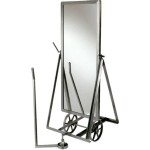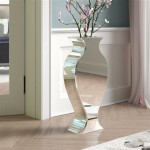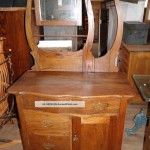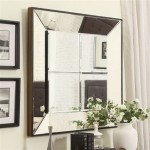How to Create an Antique Mirror Finish
The antique mirror finish, characterized by its subtly mottled and aged appearance, adds a touch of vintage elegance to any space. While authentic antique mirrors are often expensive and difficult to source, several techniques allow one to replicate the look on modern glass surfaces. This article explores the various methods for achieving an antique mirror finish, outlining the materials required and the steps involved.
One popular method utilizes specialized antiquing solutions. These commercially available products typically consist of a mixture of chemicals designed to react with the silver backing of a mirror, creating the desired aged effect. Before beginning, it is crucial to thoroughly clean the mirror surface with a glass cleaner and ensure it is completely dry. This prevents any contaminants from interfering with the antiquing process. Protective gloves and eye protection should be worn during the entire process.
Application techniques for antiquing solutions vary depending on the specific product. Some solutions are sprayed onto the mirror, while others are applied with a brush or cloth. It's essential to follow the manufacturer's instructions carefully. The solution is typically left on the mirror for a specific period, allowing it to react with the silvering. The reaction time influences the final degree of antiquing, with longer durations resulting in a more pronounced effect.
Once the desired level of antiquing is achieved, the solution is rinsed off with water, and the mirror is allowed to dry completely. Multiple applications may be necessary to achieve the desired look. After the final application and drying, a protective sealant, such as clear varnish or lacquer, can be applied to preserve the antique finish and protect the silvering from further oxidation. This sealant also adds a layer of durability to the mirror surface.
An alternative method involves using layers of paint and glaze to create a faux antique effect. This technique offers greater control over the final appearance, allowing for customization of color and texture. Initially, a base coat of paint, often in a dark shade like black or dark grey, is applied to the clean glass surface. This provides a backdrop for subsequent layers and enhances the illusion of depth.
Once the base coat is dry, a layer of metallic paint, typically silver or gold, is applied over the base coat. This layer doesn't need to be completely opaque, allowing some of the base coat to show through, adding to the aged appearance. After the metallic layer dries, a glaze is applied over the entire surface. The glaze can be tinted to achieve a specific color tone, contributing to the overall antique effect.
Before the glaze dries completely, it is partially wiped away using a clean cloth or sponge. This creates the characteristic mottled appearance of an antique mirror. The wiping technique can be varied to achieve different textures and patterns. Allowing the glaze to remain in certain areas while removing it from others creates a sense of uneven aging, mimicking the natural wear and tear of an authentic antique mirror.
A third method involves using a combination of hydrochloric acid and other chemicals to etch the mirror surface. This method is more complex and requires careful handling of hazardous materials. Appropriate safety precautions, including adequate ventilation and the use of protective gear, are absolutely essential. Because of the inherent risks, this method is generally recommended for experienced individuals familiar with handling such chemicals.
The etching process involves carefully applying the acid solution to the mirror surface, allowing it to react with the silvering for a specific duration. The reaction time determines the degree of etching and the final appearance of the mirror. After the desired effect is achieved, the acid solution is neutralized and thoroughly rinsed away. This process requires precise timing and careful monitoring to avoid over-etching and damaging the mirror. Similar to other methods, a protective sealant can be applied after the etching process to preserve the finish.
Regardless of the chosen method, creating an antique mirror finish requires patience and attention to detail. Experimentation with different techniques and materials can lead to unique and visually appealing results. Understanding the chemical processes involved and following safety precautions will ensure a successful and safe outcome. Careful consideration of the desired aesthetic and the level of complexity involved in each method will help determine the most suitable approach for a particular project.
Various resources, both online and offline, provide further guidance and detailed tutorials on creating antique mirror finishes. Consulting these resources can offer additional insights and assist in troubleshooting any potential issues that may arise during the process. Careful preparation of the work area and proper disposal of any chemical waste are important aspects to consider when undertaking this type of project.

The Ultimate Guide On Diy Antique Mirrors So Much Better With Age

How To Antique A Mirror Easy No Scratching The Navage Patch

How To Antique A Mirror Easy Diy Tutorial

Diy Antique Mirror Easy To Do And Looks Authentic My Creative Days

The Ultimate Guide On Diy Antique Mirrors So Much Better With Age

Diy Antique Mirror Tutorial 4 Easy Steps Do Dodson Designs

How To Antique Mirror Using Paint Stripper And Bleach Decor Adventures

Antiqued Mirror Effect Thicketworks

10 Tutorials On How To Antique A Mirror So Much Better With Age

How To Make Distressed Antiqued Mirror Queen Bee Of Honey Dos








